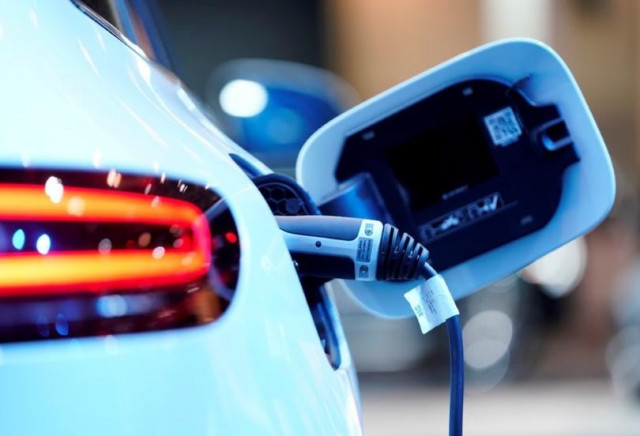Getting an electric vehicle? Good luck charging it
While EV sales are on the rise in EU and the US, delays in setting up charging infrastructure are causing a bottleneck

European and American cities planning to phase out combustion engines over the next 15 years first need to bridge the charging gap for the millions of residents who park their cars on the street.
While electric vehicle (EV) sales are on the rise in Europe and the United States, delays in setting up charging infrastructure are causing a bottleneck.
Often cash-strapped local authorities have priorities other than a curbside network of charging points that allow owners to ensure their EVs are always topped up.
And while that leaves a potential gap for the private sector, it’s one that some EV charging startups, who are early adopters in other places, are focused on.
“It’s really hard to deal with on-street residential charging, so there really aren’t many companies that have,” said Hugh McKenzie, Trojan Energy’s chief operating officer.
Shell to vastly expand electric vehicle charging network in Britain
Trojan has developed a charger that is being tested on residential streets in two London boroughs, where EV owners insert a small pole into a socket submerged in the sidewalk and then plug it into their car.
Tim Winn, an Uber driver who charges a Nissan Leaf every day, is using the system in Brent, north London.
“After driving all day I just want to come home and plug in,” said Vin, 39, who previously used a nearby EV fast charger to charge in 20 minutes, but sometimes around Had to wait in line for an hour.
A “cabby” using one of London’s new electric black taxis told Businesshala he often had to drive between charging points, losing valuable customs, only to find they were already are in use or are defective.
cost control
Using urban on-street charging solutions that include lamp post chargers or even wireless ones, like the roll out of fiber optic cables for ultra-fast broadband, will cost billions.
Solutions like Trojan are expensive because they require a grid connection. And since there are not yet enough EV owners to ensure a quick return, they are subsidized 75% by the UK government.
The Trojan’s charger costs about £7,000 ($9,520) to build and install, but Mackenzie says it would work for private investors if it could be reduced to £4,500.
But it still requires the purchase of a local authority.
“The biggest factor in whether kerbside charging is successful is whether you have an interested and engaged municipality,” said Travis Allen, vice president of public affairs at Quebec City-based FLO. .
Yet even local officials like Brent, who are trying lamp post chargers and other solutions, are simply short of cash.
Brent Council transport planning manager Tim Martin says lamp post chargers cost around £2,000 and rapid chargers cost around £15,000, so subsidies are the only option.
“The chances of being able to self fund them from my own budget are practically zero,” Martin said.
Based on car registrations and parking permits, charging startup char.gy estimates there are between 5 million and 10 million cars in London, about 76% of which are parked on the street.
Government figures show that about 40% of Britain’s 33 million cars total, while about 40% of Americans do not live in single-family homes with garages.
And while the rise of car sharing services may reduce the need for on-street charging, it’s not clear how much.
Char.gy chief executive Richard Stobart estimates that Britain will need half a million on-street chargers by 2030, when nearly half of the country’s cars should be electric. Char.gy runs a network of around 1,000 on-street lamp post chargers in the UK, which cost around £1,800 to build and install.
While government subsidies do exist, Stobart said, local officials often lack the resources.
“So they just panic and it takes forever,” he said.
Ubitricity, a Royal Dutch Shell (RDSa.L) business, is the British market leader, with only 4,000 chargers using lamp posts, which if they are close enough to the curb and use LED lamps, most of them There is enough power to charge an EV overnight. .
ubitricity CEO Lex Hartmann estimates that in densely populated areas, around 60% of Europe’s car owners will need public charging.
“You’ll need a charger at home, at work, at the supermarket, you’ll need fast charging, but mainly you’ll need charging everywhere,” Hartmann said.
“If there is no infrastructure, people will hesitate to buy electric cars unless they are forced to,” he said.
There are more than 90 million lamp posts in Europe, millions of which can be used for charging, said Hartmann, whose ubiquity also runs a lamp post charger network in Berlin.
A spokesman said the European Commission is aware that urban chargers will be “necessary to convince more and more consumers to go electric,” and has set up an expert group to advise cities.
‘Painful Experience’
Some cities face a major challenge.
New York State has set a zero-emissions target for all new passenger cars and light-duty trucks by 2035.
But New York City currently has just 1,580 charging plugs for the nearly one million cars that rely on street parking.
“It’s a really painful experience to own an EV in a big city like New York,” said Paul Suhe, co-founder of electric moped sharing startup Revel, which has launched the city’s first fast-charging hub.
An April study commissioned by New York estimated that electrifying its transportation would cost about $500 billion.
In Los Angeles, which has the most chargers of any US city, Blink Charging (BLNK.O) last year bought BlueLA, the city-run EV car sharing network, which has 100 vehicles and 200 charging stations.
Blink CEO Michael Farkas said local authorities want to charge infrastructure in as many places as possible to encourage people to buy EVs, but companies can’t afford the investment until ownership increases. go.
“You can’t just have a dream zone, you’ll be broke unless the government wants to pay for it,” Farkas said.
Even in Norway, where state support has put it at the forefront of the electric shift, rolling out on-street charging is tough.
Oslo subsidizes large public chargers and rapid chargers, investments that pay off within three to six years, said Sture Portvik, who leads its charging infrastructure efforts.
But making charging accessible to the 30% of car owners who lack designated parking in a city that will begin banning fossil-fuel cars in the next few years is a bigger challenge.
“It is extremely important that everyone, regardless of their economic background, be part of the green shift,” Portwick said. “And they have to because in a few years they will have to sell their diesel cars.”



















COMMENTS
Comments are moderated and generally will be posted if they are on-topic and not abusive.
For more information, please see our Comments FAQ